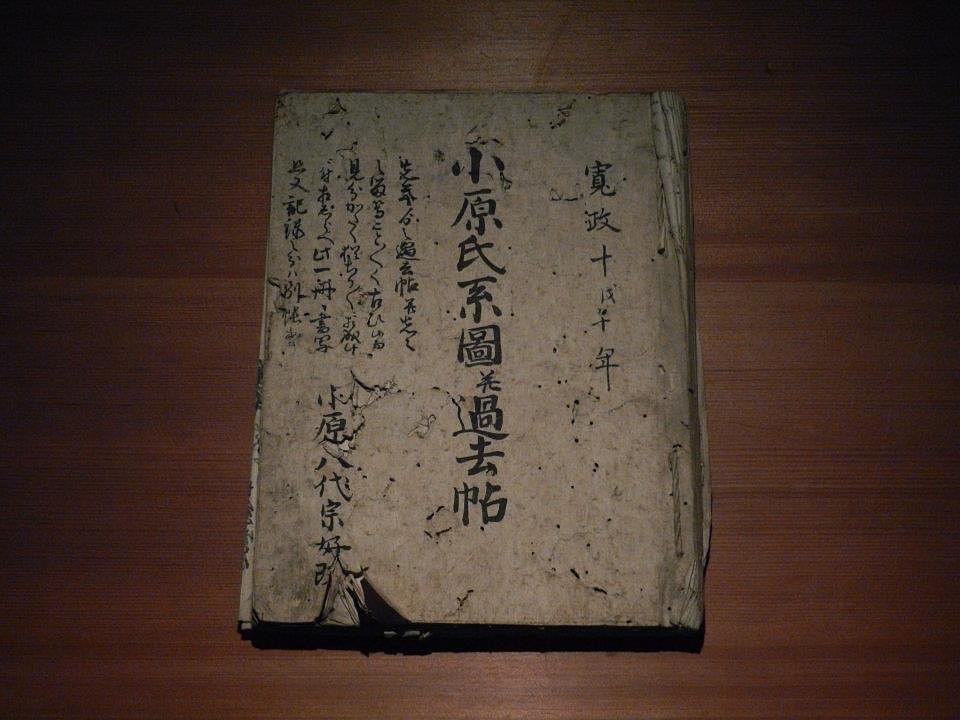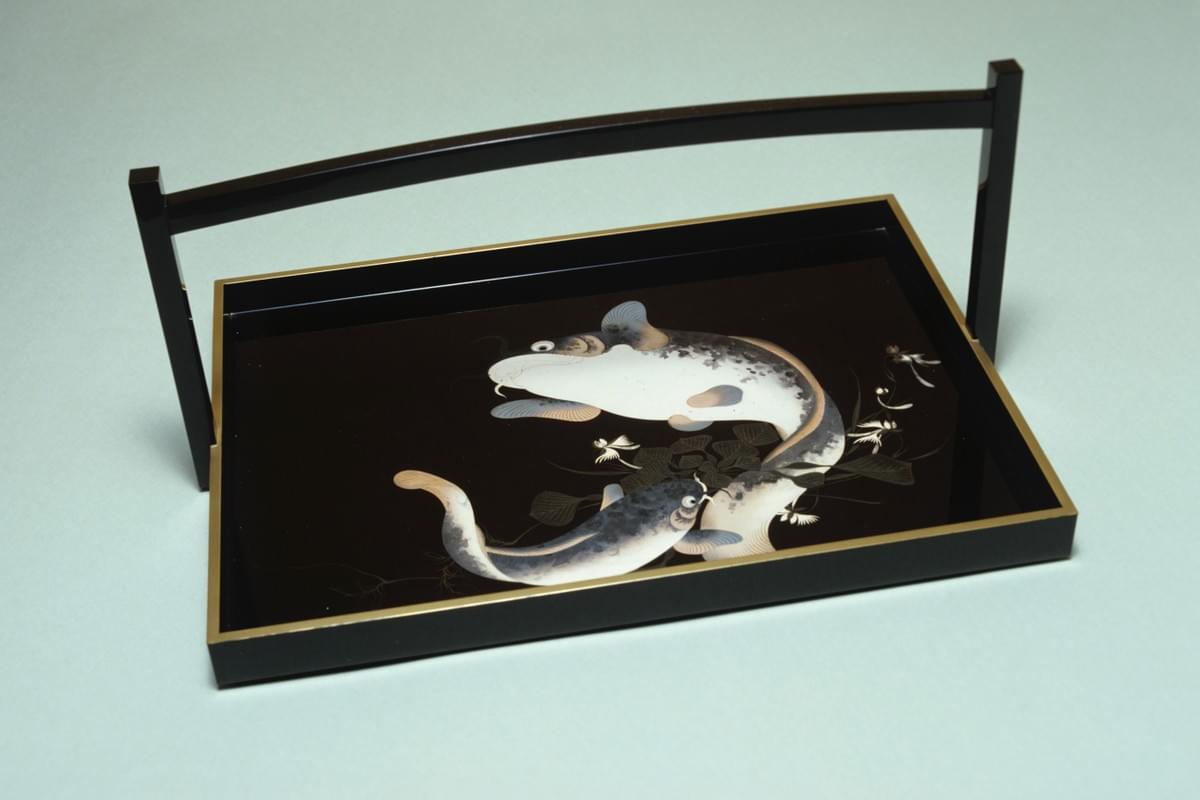
城端蒔絵について
About Jōhana Makie
- Since 1575 -

城端蒔絵のはじまり
The Beginnings of Jōhana Maki-e
小原家は、第五十九代「宇多天皇」の第八皇子「敦實親王」を祖とする近江源氏・佐々木氏の流れを汲む。文明7年(1475)、本願寺八世 蓮如が越前から加賀・越中へと赴く際に、近江源氏・佐々木高範の裔で、越前朝倉義景の家臣であった佐々木入道祐玄が随身して、砺波郡梅原村(南砺市梅原)に来て定住した。祐玄は文亀年間(1501-1504)に80余歳で没したが、その曾孫佐々木又兵衛之綱が天正元年(1573)、23歳のときに城端へ移住し、同3年(1575)に大工町で髹工(塗師屋)を家業として塗師屋又兵衛と名乗り、「城端塗」の基礎をきずいた。これが小原家における塗師としての元祖であり、城端漆工のはじまりでもある。
その頃、南朝の遺臣 畑六郎左衛門時能の裔で、佐々木氏とも一族である畑治五右衛門好永という漆工が城端近郊の大鋸屋村に住んでいた。好永は天正年間(1573-1592)に肥前長崎で唐人から「彩漆密陀絵法(いろうるしみつだえほう)」を学び、城端に伝え「城端蒔絵」の基礎をきずいた。
好永はその技法を息子の二代 治五右衛門宜安に伝えた。しかし宜安は後に医師に転じたので、塗師屋又兵衛の孫の三代 徳左衛門信好に密陀絵法を伝授した。承応3年(1654)、信好37歳のときである。これより信好は、自家伝来の髹漆の技法に彩漆密陀絵法を加えてさらに研鑽を積み、白蒔絵の特色をつくって多くの作品を制作した。
加賀藩五代藩主 前田綱紀が、当時諸国名工の最高水準の技法を集めた「百工比照」という技術資料がある(東京駒場・前田育徳会蔵)。そのなかに、五十嵐道甫・椎原市太夫らとともに、治五右衛門の城端塗があげられていることは、当時の城端蒔絵の水準の高さを示すものである。これは信好の作品ではないかと推定されている。
信好の長男、四代 理右衛門亮好は従来の家名「佐々木」を廃して「小原」と改姓し、六代 治五右衛門忠好以降、代々「小原治五右衛門」を襲名している。
The Ohara family descended from the Omi-Genji and Sasaki clan, whose ancestor was “Imperial Prince Atsumi,'' the eighth prince of the 59th “Emperor Uda''. In the year 1475, when Rennyo, the 8th head-priest of the Hongan-ji Temple travelled from Echizen (present day Northern Fukui Prefecture) to Kaga (Southern Ishikawa Prefecture) and Etchu (Toyama Prefecture), he was attended by a vassal of the Echizen warlord Yoshikage Asakura, Nyudo Yugen Sasaki, descendant of Takanori Sasaki, a member of the Omi-Genji clan. Nyudo Yugen settled down in a village called Umehara in the Tonami District (present day Umehara, Nanto city, Toyama Prefecture), and passed away at the age of 80 some time between 1501 to 1504. His great-grandson Yukitsuna Matabei Sasaki moved to Jōhana in 1573 at the age of 23, starting the family lacquering business in Daikumachi town, adopting the name Matabei the Lacquerer, thus the foundation of “Jōhana Lacquering” was built. This became the origin of the Ohara’s family lacquer trade tradition, and marks the beginning of Jōhana Lacquering.
At that time, an urushi lacquerer from another branch of the Sasaki clan, HATA Jigoemon (Yoshinaga), lived in the Village of Ogaya near Jōhana. A descendant of HATA Rokurozaemon (Tokiyoshi), who served the Southern Court in the previous civil war, Yoshinaga learnt the art of “Multi-Coloured Mitsuda-e” from Tang Dynasty Chinese in Nagasaki, Hizen ( present day Saga and Nagasaki Prefectures),some time during the Tensho period (1573 to 1592). By bringing such techniques to the Jōhana area, he played an important role in building the foundation of Jōhana Maki-e.
The techniques of Yoshinaga were succeeded by his son, HATA Jigoemon II (Gian). Gian later became a medical doctor, however, and taught those techniques to the grandson of Matabei the Lacquerer, Nobuyoshi Tokuzaemon, the third successor of the family in 1654, when Nobuyoshi was 37 years of age. Nobuyoshi combined the traditional lacquering techniques of his family with the Multi-Coloured Mitsuda-e techniques, and after much diligent effort, he developed the characteristic white maki-e, creating many wonderful pieces.
The fifth lord of Kaga, Tsunanori Maeda, compiled an encyclopaedia of crafts, “A Comparison of One Hundred Crafts” (Maeda Ikutokukai Collection, Komaba, Tokyo), recording in its pages the most skillful craftsmen and their most famous arts from all corners of the country. Listed among renowned artists such as Doho Igarashi and Ichidayu Shiihara was the Jōhana Lacquering of Jigoemon, indicating the superb quality of Jōhana Maki-e at the time. The works featured in the encyclopaedia are thought to be creations by Nobuyoshi.
Sukeyoshi Riemon, the fourth successor and the eldest son of Nobuyoshi, discarded the old family name of Sasaki and replaced it with Ohara. From the sixth successor, Tadayoshi Jigoemon, the name of “Jigoemon Ohara” has been passed down from generation to generation.

城端蒔絵の特色
The Characteristics of Jōhana Maki-e
城端蒔絵は「城端塗」または「治五右衛門塗」とも呼ばれ、美術工藝界に特異な存在として知られており、一般の蒔絵とは趣を異にする。
元来、漆で発色することのできるのは、朱・黒・黄・緑・茶の五彩に限られ、白を発色することは不可能とされていた。城端蒔絵はこの白色を表すことを特色とし、花鳥文様などを描いて生態そのままの色調ぼかしを表現する彩漆蒔絵技術を一子相伝の秘法として今日まで伝えるものである。これには、初期の作品に多く見られる「密陀絵法」と、それを基にしてさらに工夫を加え創出された、中期以降の作品に多く見られる「白蒔絵法」とがある。
蒔絵とは本来、漆で文様を描きその上に金銀の粉を蒔き付ける技法であるが、加賀藩では加賀蒔絵保護のため藩外での金銀の使用を禁じた。豪奢な加賀蒔絵に対して、城端蒔絵は白をはじめ各種の色彩を自由に駆使し、瀟洒で雅味のある独特の様式を案出したものである。
Also known as Jōhana Lacquering or Jigoemon Lacquering, Jōhana Maki-e is a unique curiosity in the world of fine and applied arts, and completely different from conventional maki-e.
In regular maki-e, only the five colours of red black, yellow, green and brown can be developed from the lacquering, and it was deemed impossible for the colour white to be formed. Jōhana Maki-e, however, characteristically makes use of the colour white, developed using secret techniques for multi-coloured maki-e passed down from a single line of succession, and its availability makes a wide variety of colour shadings possible when drawing wildlife and nature and other scenery. This technique combines the litharge techniques seen in the early works of the family, and through much research and hard work based on those techniques, it became the “White Maki-e” seen in works some time around the middle of the line of succession.
Originally, maki-e is an artform where gold and silver powder is sprinkled on patterns drawn with lacquer, but the warlord of Kaga prohibited the use of gold and silver outside of his feudal domain in order to protect the local Kaga Maki-e. In contrast to the extravagant Kaga Maki-e, Jōhana Maki-e uses a variety of colours made possible by the white lacquer, creating unique illustrations that are vivacious yet elegant.

@jigoemon16
© Jigoemon Ohara All rights reserved.


